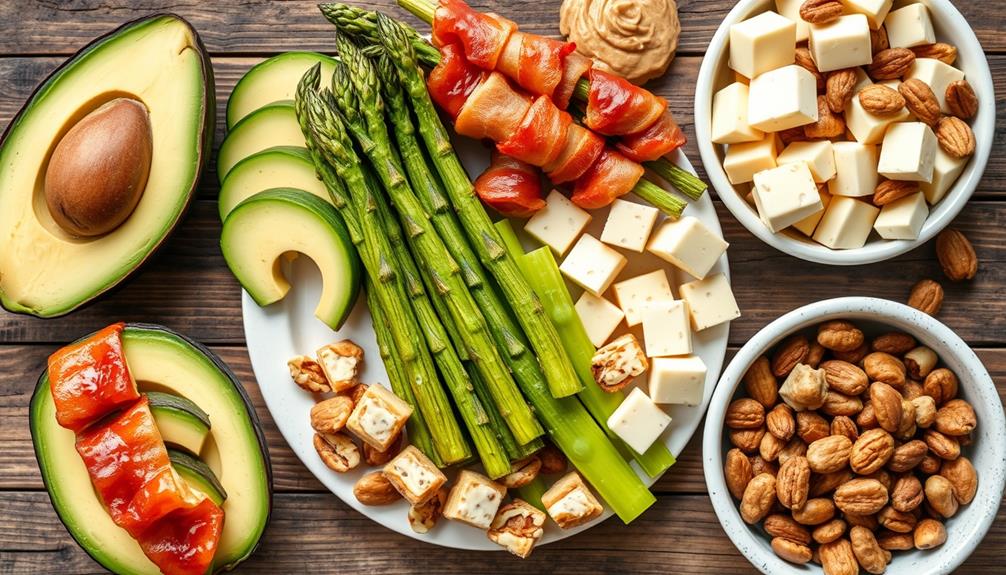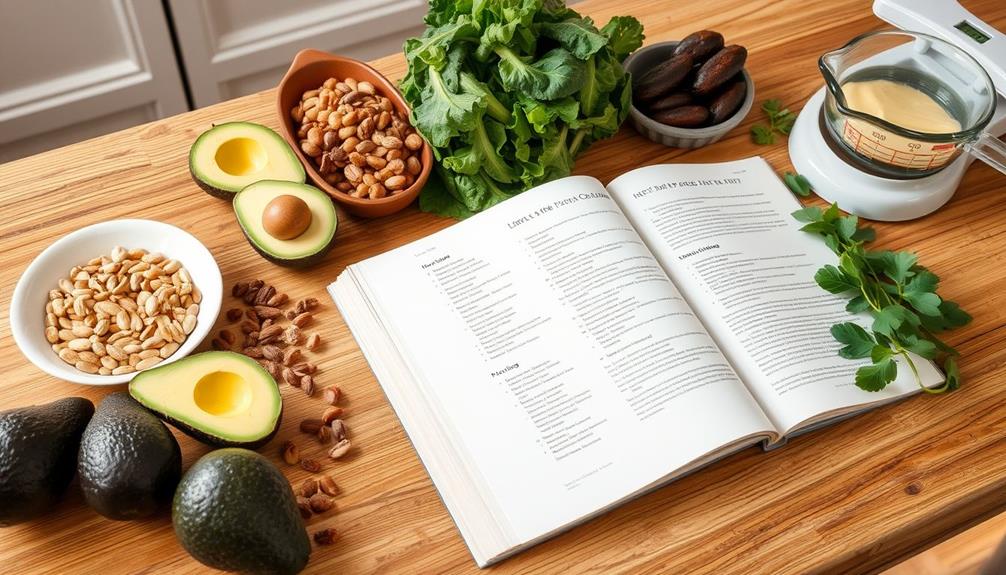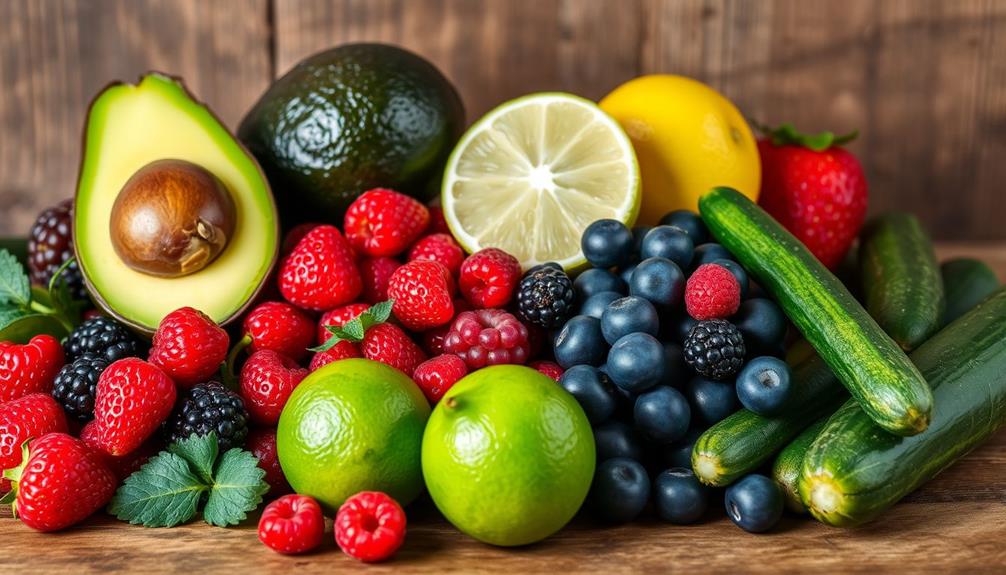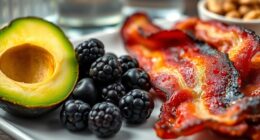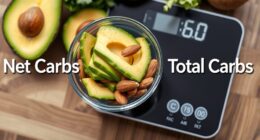You can easily start a keto diet at home by focusing on high-fat, low-carb meals. Aim for 70-75% fat, 20-25% protein, and only 5-10% carbs in your meals. Include healthy fats like avocados and olive oil, and choose fatty cuts of meat and low-carb veggies such as spinach and zucchini. Eliminate sugary foods, grains, and starchy vegetables to stay within your carb limits. Meal prep can save you time and keep you on track. Stay hydrated and track your progress to maintain motivation and adjust your diet as needed. Discover more strategies to make your keto journey successful. It’s important to also pay attention to your electrolyte intake, as the keto diet can affect your body’s balance of sodium, potassium, and magnesium. Consider taking supplements or incorporating electrolyte-rich foods like leafy greens and nuts into your meals. Additionally, be mindful of hidden carbs in sauces, condiments, and dressings, as they can easily add up. By focusing on these keto diet basics, you can set yourself up for success and effectively reach your health and wellness goals.
Key Takeaways
- Focus on a diet composition of 70-75% fat, 20-25% protein, and 5-10% carbs to achieve ketosis effectively.
- Plan meals using keto-friendly foods like avocados, fatty meats, low-carb vegetables, and healthy oils.
- Avoid high-carb foods such as sugars, grains, starchy vegetables, and most fruits to maintain low carbohydrate intake.
- Stay hydrated and consider electrolyte supplementation to manage common side effects during the transition to ketosis.
- Track your progress by measuring ketone levels and monitoring macronutrient intake to ensure adherence to the diet.
Understanding the Keto Diet

Frequently, people wonder what the Keto Diet is all about and how it works. The ketogenic diet is a high-fat, low-carb diet that typically consists of 70-75% fat, 20-25% protein, and a mere 5-10% carbohydrates. By greatly limiting your carbohydrate intake to around 20-50 grams per day, you can induce a metabolic state known as ketosis.
In ketosis, your body shifts its primary energy source from carbohydrates to fats, using ketones produced in the liver as an alternative fuel when glucose levels are low. This dietary approach not only aids in weight loss but also aligns with other health practices, such as maintaining adequate hydration, which is essential for overall wellness and can support juice diets.
This shift can lead to effective weight loss, as your body begins to burn stored body fat for energy. However, it's important to monitor your daily calories and macronutrient ratios to stay on track.
The Keto Diet was initially developed in the 1920s to treat epilepsy but has gained popularity for its potential health benefits, including improved appetite control and metabolic efficiency. Before diving into this lifestyle, it's wise to consult healthcare professionals, especially if you have pre-existing health conditions.
Understanding the fundamentals of the Keto Diet will help you make informed decisions on your journey toward a healthier lifestyle.
Benefits of Going Keto

Embracing the Keto Diet can lead to a variety of impressive benefits for your health and wellness. One of the most notable advantages is significant weight loss; many people experience an average loss of 2 pounds more than those on low-fat diets within the first 3-6 months. This occurs as your body shifts to burning fat for energy.
Additionally, incorporating balanced diet principles can further enhance your results by ensuring you're getting the necessary nutrients while on a ketogenic plan. Improved blood sugar control is another key benefit, with around 60% of type 2 diabetes patients reversing their condition on a ketogenic diet.
You might also notice increased energy levels and enhanced mental clarity, thanks to ketone production, which provides an efficient fuel source for your brain.
Additionally, the ketogenic diet can reduce seizure frequency in epilepsy patients, especially those resistant to medication, offering a valuable non-pharmaceutical management option.
Furthermore, you could experience potential improvements in cholesterol levels, like reduced triglycerides and increased HDL cholesterol, which may contribute to better overall cardiovascular health.
Foods to Include

When starting a ketogenic diet, you'll want to focus on incorporating a variety of high-fat foods that fuel your body effectively. Aim for 70-80% of your daily caloric intake to come from healthy fats like avocados, nuts, seeds, and oils. Protein sources like fatty cuts of meat, poultry, eggs, and low-carb dairy should make up 15-25% of your total calories.
Including low-carb vegetables such as spinach, kale, broccoli, and zucchini is essential for providing vitamins and minerals while keeping your carb intake below 50 grams per day. This balanced approach can help you maintain ketosis and maximize the keto diet help you're seeking.
Here are some meal ideas to inspire you:
| High-Fat Foods | Protein Sources |
|---|---|
| Avocados | Fatty cuts of meat |
| Olive oil | Eggs |
| Nuts and seeds | Low-carb dairy |
| Coconut oil | Poultry |
Foods to Avoid
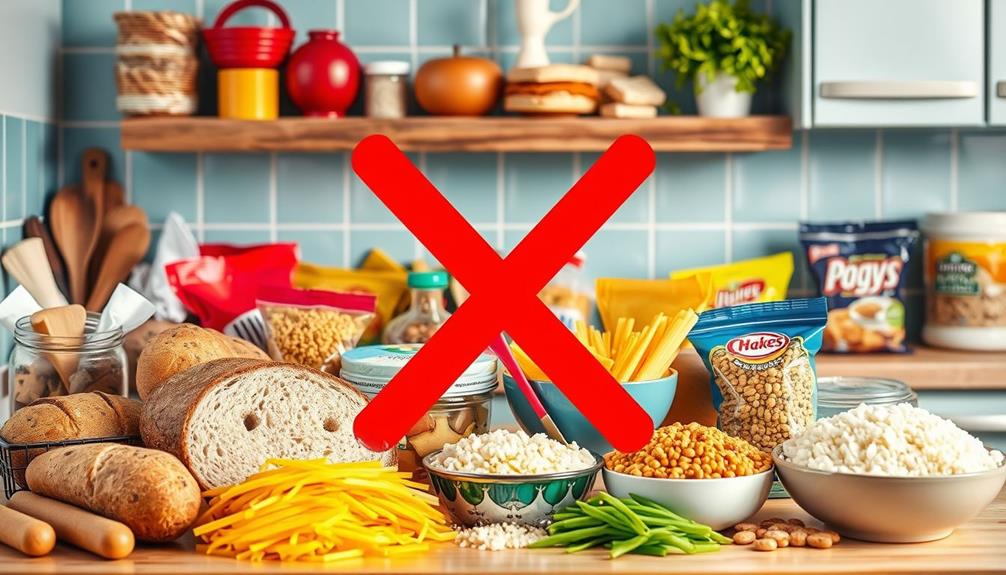
To successfully follow a ketogenic diet, it's just as important to know what to avoid as it's to understand what to include in your meals. Start by eliminating sugary foods like soda, fruit juice, candy, and baked goods. These can greatly increase your carb intake and disrupt your ketosis.
In addition, it's crucial to be aware of potential side effects and interactions of certain foods, similar to how you'd consider cold medications overview when seeking relief from a cold.
Next, limit grains such as bread, pasta, rice, and cereals. They're high in carbs and can hinder your shift into a ketogenic state.
Starchy vegetables, including potatoes, corn, and carrots, should also be avoided, as they contain levels of carbohydrates that can push you over your daily limit.
When it comes to fruits, you'll need to be cautious. Most fruits are high-carb, but you can enjoy low-glycemic options like berries in moderation.
Finally, steer clear of processed foods, including high-carb snacks like chips and cookies. These often contain hidden sugars and unhealthy additives that compromise your diet's effectiveness.
Meal Planning Strategies

Effective meal planning is essential for successfully managing the ketogenic diet at home. Start by focusing on your macronutrient ratio: aim for 70-75% fat, 20-25% protein, and just 5-10% carbohydrates, which means keeping carbs under 50 grams daily.
Creating a weekly menu featuring keto-friendly foods like fatty meats, eggs, low-carb vegetables, nuts, and healthy oils is key. Avoid high-carb items such as bread and sugary snacks. Use meal prep techniques to streamline your process and reduce the temptation to stray.
Here's a simple table to help you organize your meals:
| Day | Breakfast | Dinner |
|---|---|---|
| Monday | Scrambled eggs | Grilled chicken |
| Tuesday | Keto smoothie | Zucchini noodles |
| Wednesday | Omelet with spinach | Beef stir-fry |
| Thursday | Greek yogurt | Salmon with asparagus |
Additionally, keep a food diary or use tracking apps to monitor your carbohydrate intake. Experiment with various keto recipes to keep things fresh and enjoyable. Batch cooking can also save time and help you stick to your plan effortlessly.
Cooking Tips for Keto

Cooking on a keto diet can be a delicious adventure when you plunge into the right techniques. By focusing on healthy fats, low-carb substitutes, and non-starchy vegetables, you can create meals that aren't only satisfying but also meet your high-fat requirement.
Understanding the importance of brewing methods can also enhance your dining experience, especially when pairing your meals with the perfect coffee.
- Use healthy fats like olive oil, avocado oil, and coconut oil for cooking; they enhance flavor and nutrient absorption.
- Experiment with low-carb substitutes, such as zucchini noodles or cauliflower rice, to replace traditional high-carb ingredients in your favorite recipes.
- Incorporate a variety of non-starchy vegetables like spinach, broccoli, and bell peppers to guarantee you're getting essential vitamins and minerals without exceeding your carb limit.
Meal prep is key to success on the keto diet. By preparing meals in advance, you'll have quick access to healthy options that help reduce temptation for high-carb convenience foods.
Don't forget to use herbs and spices; they add flavor enhancement without any carbs. Experiment with fresh basil, cilantro, or garlic to elevate your dishes.
These cooking tips will keep your meals exciting and aligned with your keto goals!
Managing Side Effects

Many people experience side effects when starting the keto diet, commonly referred to as "keto flu." This can include symptoms like fatigue, headaches, and irritability as your body adjusts to burning fat for fuel instead of carbohydrates.
To alleviate these symptoms, focus on hydration and increase your electrolyte intake, particularly sodium, potassium, and magnesium. Additionally, incorporating practices like gentle stretching before bedtime can help relax your muscles and improve your overall well-being during this adjustment.
Instead of drastically cutting carbs, gradually reduce your carbohydrate intake over a week. This slower adjustment can help your body adapt and minimize side effects. Incorporating high-fiber, non-starchy vegetables into your meals can also help mitigate digestive issues like constipation, which many face during the initial phases of keto.
Eating small, frequent meals that include healthy fats can maintain your energy levels and reduce feelings of hunger, which can contribute to irritability.
It's essential to monitor your body's response to the diet closely. If side effects persist, don't hesitate to consult a healthcare professional for personalized guidance and adjustments. This proactive approach can make your keto journey smoother and more enjoyable as your body adapts.
Importance of Hydration

Here are a few key reasons to prioritize hydration:
- Maintains energy levels, preventing fatigue.
- Supports metabolic processes and overall health.
- Helps balance essential electrolytes like sodium, potassium, and magnesium. Staying hydrated is particularly important for individuals on specialized diets, such as those exploring precious metal investments, as it can impact decision-making and energy levels.
Including electrolyte-rich fluids, like broth or mineral water, can further support your hydration efforts.
These electrolytes are crucial for maintaining balance in your body, especially on a low-carb diet.
Remember, monitoring your water intake can greatly enhance your experience on the keto diet.
Staying hydrated not only helps you avoid dehydration but also keeps your energy levels up and your body functioning at its best.
Tracking Your Progress
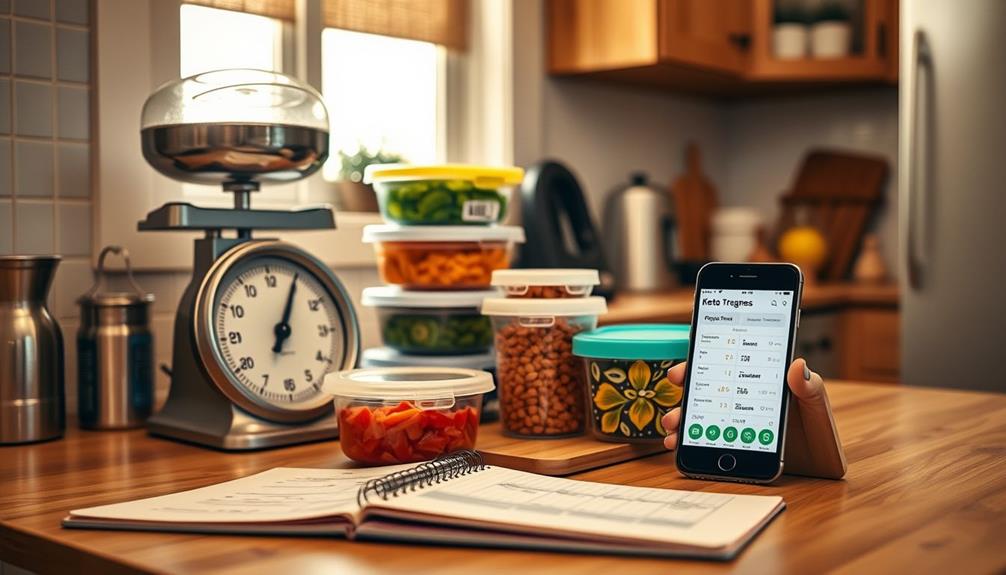
Tracking your progress on the keto diet is essential for success. You should measure your ketone levels regularly and monitor your macronutrient intake to guarantee you're staying in ketosis.
Additionally, establishing a budget for your grocery shopping can help you manage costs while focusing on keto-friendly foods. These steps will help you stay accountable and make adjustments as needed, especially when considering budgeting essentials.
Measuring Ketone Levels
Measuring your ketone levels is crucial for staying on track with your ketogenic diet. By monitoring ketosis, you can verify you're within the ideal range for achieving nutritional ketosis, which typically falls between 0.5 to 3.0 mmol/L.
Understanding your body's response to dietary changes can help you make informed decisions regarding your meals and snacks, especially when considering various free crypto opportunities.
There are three primary methods to measure ketone levels:
- Blood ketone meters: These provide the most accurate results and are ideal for precise tracking.
- Urine ketone strips: A cost-effective option for beginners, though they can become less reliable as your body adapts to ketosis.
- Breath analyzers: A non-invasive method that detects acetone, albeit with variable accuracy.
Regularly tracking your ketone levels can help you adjust your macronutrient intake to stay in nutritional ketosis.
As you progress, you may find that your ketone levels fluctuate, so it's important to measure consistently. This way, you'll be able to fine-tune your diet and enhance the effectiveness of your ketogenic journey.
Whether you choose blood meters, urine strips, or breath analyzers, finding the right method for you is key to successful measuring and maintaining those all-important ketone levels.
Monitoring Macronutrient Intake
Staying on top of your macronutrient intake is essential for successfully managing the keto diet. To effectively track your daily carbohydrate consumption, aim to stay below 20-50 grams to guarantee you remain in ketosis. Utilizing mobile apps or food diaries can simplify logging your food consumption and calculating your macronutrient ratios.
| Macronutrient | Recommended Ratio |
|---|---|
| Fat | 60-80% |
| Protein | 15-30% |
| Carbohydrates | 5-10% |
Familiarize yourself with food labels and serving sizes to accurately assess the macronutrient content of what you eat. Consider using a food scale to measure portions; precise measurements can greatly contribute to your successful weight loss and health benefits.
Regularly review your progress and adjust your intake based on your goals. Keep in mind that individual responses to the keto diet may vary, so tailor your approach as needed. By staying diligent in tracking and measuring, you'll set yourself up for success on your keto journey.
Finding Support and Resources

Finding support and resources is essential for successfully managing the Keto Diet at home. You don't have to navigate this journey alone; many tools and communities can help you stay on track and motivated. Exploring best websites to earn money online can also provide insights into budgeting for your dietary needs as you shift to a new eating plan.
- Online resources: Websites like the Cleveland Clinic and Mayo Clinic provide expert insights on dietary requirements and health implications.
- Support groups: Joining online forums allows you to connect with others, enhancing motivation and adherence through shared experiences and tips.
- Meal planning tools: Utilize apps to track your macronutrient intake, ensuring you stick to the recommended ratios of 70-75% fats, 20-25% protein, and 5-10% carbohydrates.
Consulting with healthcare providers or a registered dietitian offers personalized guidance tailored to your specific dietary needs, especially if you have pre-existing health conditions.
Additionally, using health tools and calculators can help you track progress and adjust your meal plan as your goals evolve.
Frequently Asked Questions
How Can I Start Keto Diet on My Own?
To start your keto diet, calculate your macronutrient ratios, create a meal plan focused on high-fat, low-carb foods, stock your kitchen with keto staples, and track your intake to guarantee you're staying on track.
What Is a Keto Diet Plan for Beginners?
Imagine shedding pounds like a snake shedding its skin. A beginner's keto diet plan emphasizes high fats, moderate protein, and minimal carbs. Focus on avocados, nuts, leafy greens, and ditch the grains and sugars. You've got this!
What Is the Simplest Way to Do Keto?
The simplest way to do keto is to cut carbs dramatically, boost healthy fats, and plan your meals. Focus on easy recipes, track your intake, and stay hydrated to ease the shift.
What Are the 9 Rules of Keto?
To succeed on keto, stick to these rules: limit carbs to 20-50 grams, prioritize healthy fats, moderate protein, stay hydrated, balance electrolytes, plan meals, read labels, avoid hidden carbs, and track your progress.
Conclusion
So, you've mastered the art of going keto at home—who knew avoiding bread could be your greatest achievement? As you savor those avocados and cheese, remember that while you're saying goodbye to carbs, you're really just making room for a whole new relationship with food. Embrace the journey, track your progress, and don't forget to hydrate! After all, who needs cake when you've got a fridge full of delicious fats? Happy ketoing!

